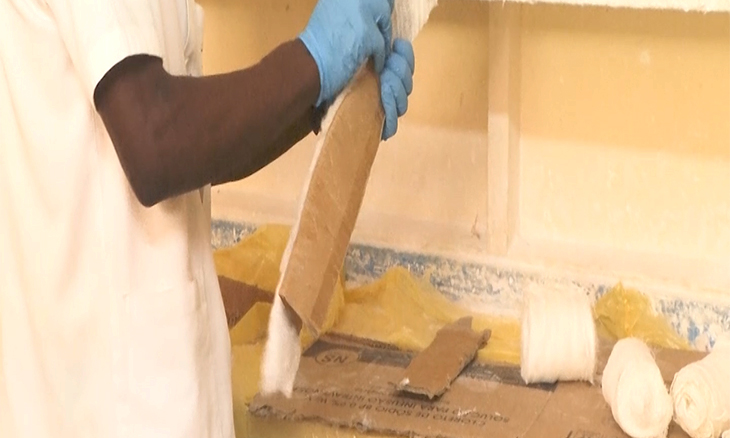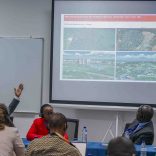Mozambique must improve climate change response
Mozambique: Doctors use cardboard for casts due to lack of plaster – Watch

Photo: O País
There is a lack of plaster for casts in hospitals. In Nampula, cardboard is used to improvise treatment for fractures. The Minister of Health acknowledges the crisis and says it is due to the abandonment of the plaster supply contract by the company that won the tender.
This reality covers most of the country’s public hospitals. There is a lack of plaster for splints (casts), leading to many patients with fractures or other types of trauma not receiving optimal care. Those who can afford to do so purchase the plaster from private pharmacies.
At Nampula Central Hospital, the largest health unit in the north of the country, technicians in emergency orthopaedics and traumatology use wet cardboard to treat patients.
Afternoon of Friday, July 12th. Jorge Francisco walks down the corridor to the orthopaedics emergency room accompanied by his son, who was run over by a motorbike three weeks ago and suffered damage to the bone in his left leg.
The hearing-impaired young man jumps around, hanging by his armpits from two sticks that serve as crutches, avoiding stepping on the ground with his thick leg wrapped to the knee in a bandage.
“It’s the third week and we came to check,” the father says.
The check should have been on the condition of the leg and to reinforce it with more plaster, but the answer they got from the doctor was peremptory: “He said the hospital doesn’t have any plaster.”
Without plaster for the cast at the hospital, Senhor Jorge thinks of alternatives “I don’t know. I’m going to ask family members to see if I can buy more plaster to put it back on, because I’m not satisfied with it the way it is.”
In the room where casts are put on and removed, the situation is bleak. Among the patients we found a six-year-old boy with a curved right forearm, the result of his getting cardboard and bandage treatment a month ago, due to lack of plaster.
The boy’s father, Gonçalves António, explains that the boy fell from the roof of the house when he was trying to remove cassava that had been left to dry. He broke the bones in his forearm. “When I arrived here at the hospital on June 10th, they put a splint and cardboard on it,” he says.
Because it is not the appropriate material to immobilize the broken bones and allow them to knit and regenerate, the boy’s forearm has a pronounced curve and the bones have not even come together. The only solution found was to add more cardboard, because there is no plaster.
The scenario is stressful for healthcare staff, who are forced to provide inadequate service. They barely answer our questions in the tiny room, their silence revealing their weariness.
“I am not allowed to speak. I’m not responsible here,” says one of the orthopaedic doctors, while applying bandage and cardboard to another patient. The harsh reality is the little boy returning home with another piece of cardboard instead of plaster, not knowing whether the inappropriate treatment will leave him with a defective forearm for the rest of his life.
In line for the same procedure was Espera Juma, father of a boy who fell at school and injured his left arm. Having watched the scenario described above, he learned that his son was next in line for the cardboard instead of plaster treatment.
“I don’t know what I can say, but as soon as the government sees it, there will be alternative means for this to happen,” he utters.
This is not the situation in Nampula alone. At Matola Provincial Hospital, for example, patients requiring trauma care are referred to Maputo Central Hospital, which is why the latter experiences crowding.
Other parts of the country also lack plaster.
At the Beira Central Hospital, there is greater concern at a four-fold increase in accidents compared to last year, leading to the exhaustion of the plaster supply for the entire year.
“The acquisition process in the health sector follows a cycle that covers an entire year. In 2021, we held a tender to supply gypsum to the healthcare sector for 2022 and the first quarter of 2023. The winner of the tender, after being awarded, withdrew from the tender in the middle of the year. As a consequence, we had to go to the second winner to supply the plaster for 2023 and the first quarter of 2024,” explained Minister of Health Armindo Tiago, who was in Nampula on Thursday.
The minister did not name the company that abandoned the contract in the middle of execution nor the reasons for doing so, citing ethical issues.
“The fundamental thing is that, from the 15th of this month, we will have the situation back to normal through the use of emergency mechanisms, but the emergency mechanisms, as you know, also take between four and six months to be activated.”













Leave a Reply
Be the First to Comment!
You must be logged in to post a comment.
You must be logged in to post a comment.